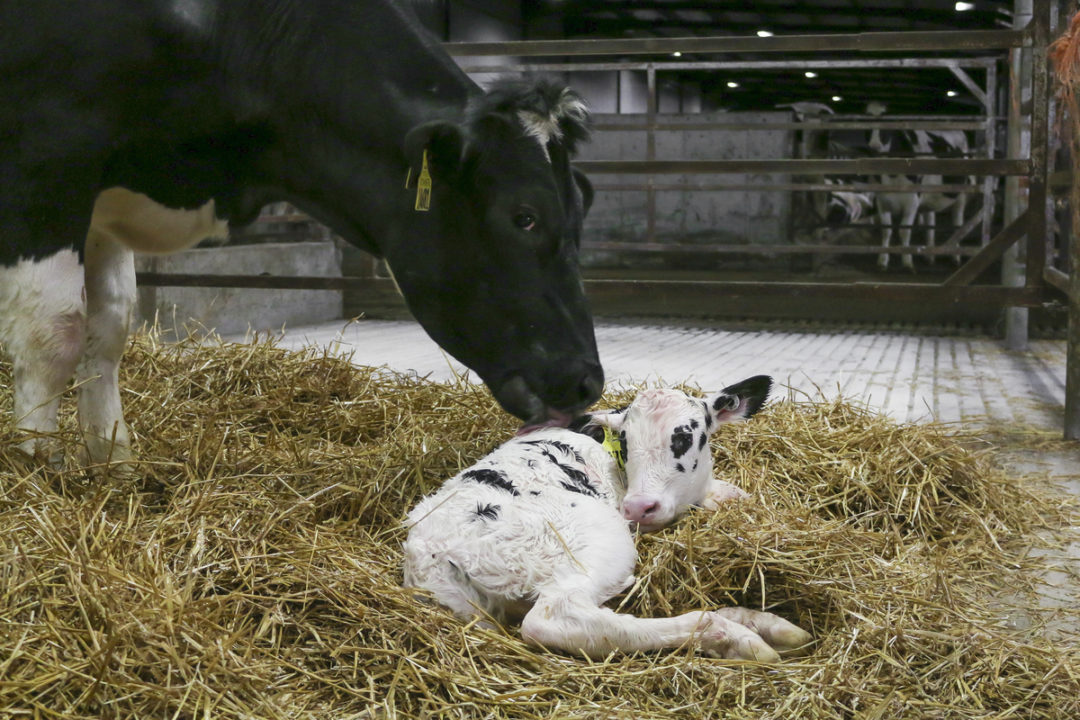There is a 90-day window where cows undergo major changes and challenges. This time, known as the transition period, occurs 60 days prior to calving through 30 days post-calving. As cows dry off, calve and reenter the milking herd, it is imperative they receive top-notch care and that strong protocols are in place for the transition period. To provide the best care to transition cows, we must understand how the transition period affects production, reproduction and overall health.
Many factors, including various environmental factors, affect the transition period:
- Temperature control – During the transition period, cows require comfortable environments to prepare for and recover from calving. During warmer months, fans and sprinklers are encouraged to keep cows cool. Heat stress on a pregnant cow will not only affect the cow but the calf as well.
- Stocking density – In lactation groups past 30 days in milk, the stocking density can or may be higher than in a transition cow group. It is imperative when populating a transition pen to consider the available amount of bunk space, stalls or space to lay down, and accessibility to a water trough. Bunk space is crucial, as transition cow rations provide the cows with vitamins, minerals and energy they need to transition smoothly.
- Bedding – When it comes to bedding, the type of bedding is far less important than providing clean, dry bedding for a cow to calve on.
- Pens – Throughout the transition period, cows experience at least four pen changes as they move from the dry cow pen, close-up pen, maternity pen and fresh cow pen. During these moves, it is important to keep cows as calm as possible and keep the pen changes minimal. If possible, keep your transition cow pens close to one another to minimize transition cow stress.
To set cows up for success in their next lactation, they must be properly cared for in their previous lactation. Following dry-off protocols to avoid dry-period mastitis or illnesses start the transition period on the right path.
There are several illnesses that can overwhelm a cow’s immune system during the transition period. Hard pulls, twins or dystocia can also lead to increased risk of transition cow illnesses.
- Mastitis – Mastitis can occur at any point in the transition period. If a cow is not properly dried off, she may experience mastitis as a dry cow, or right away in her lactation.
- Hypocalcemia – Hypocalcemia stems from low levels of calcium in the bloodstream and can lead to more serious health issues. The liver can get overwhelmed if a cow is experiencing hypocalcemia, and calcium and phosphorus deficiencies can lead to a retained placenta and/or metritis. A correct ratio of calcium and phosphorus is necessary to overcome and prevent future cases of hypocalcemia and expel the placenta.
- Retained placenta – If the placenta does not expel within 24 hours of calving, it is classified as retained.
- Metritis – Often following a retained placenta, metritis is inflammation of all layers of the uterus, along with a bacterial infection. Cows with metritis present foul-smelling, watery, brown vaginal discharge.
- Ketosis – When a cow faces a negative energy balance, she begins to start burning fat to produce glucose. The side effect of this metabolic process is a spike in ketone bodies, causing ketosis. Ketosis can cause a drop in milk production, changes in weight and a lack of energy. Without this necessary energy, cows cannot get over their illnesses on their own.
No matter what the illness is that threatens a cow’s well-being, early detection is key to her recovery. With early detection, the cow can recover quickly, using more energy to increase milk production and less energy to heal or fight infection.
To overcome the transition cow challenges outlined above, these simple protocols can be followed:
- Seven days prior to calving – increase energy in the diet or provide supplemental oral energy.
- One day prior to calving – provide supplemental calcium.
- Day of calving – provide supplemental calcium and an anti-inflammatory.
- Five days post-calving – supply supplemental energy to avoid a negative energy balance and ketosis. Use the CMT to identify early mastitis.
Metabolically during the transition period, the cow’s body is operating one way, but immediately after calving, the body begins to operate in a different way. After calving, the demand for minerals and energy increases. In response to this change, inflammation may occur to try to recover and heal.
Phosphorus, calcium and vitamin D are among the most important vitamins and minerals needed around calving and throughout the transition period. High levels of phosphorus can help cows in overcoming hypocalcemia and liver failure. Calcium is instrumental in expelling the placenta and preventing hypocalcemia and liver failure. Providing some form of these vitamins and minerals to cows will assist them in getting past calving challenges.
Inflammation is very demanding of energy. Exacerbated from this inflammation, high-producing cows need more minerals and energy than low-producing cows, and first-calf heifers facing the challenge of calving for the first time also need great amounts of energy to recover.
To start cows on a path to success and quick recovery at calving, anti-inflammatories on the day they calve are very beneficial. It is, however, important to be selective on what kinds of anti-inflammatories are being utilized so as not to suppress the cow’s immune system. Additionally, it is important to remember that cows may decrease eating and rumination around calving. The walls of the abomasum will be more susceptible to gastric acid because of an empty stomach.
Clinical issues are emphasized during the transition period because we can more easily measure the illnesses that we can see; however, it is difficult to understand the impact of subclinical illnesses. If we fail to prevent transition cow illnesses, the protocols we use to treat them are fairly standard. However, it is important to remember that due to antibiotic resistance, efficacy may be decreased, and those standard protocols may need to be reconsidered.
When transition cow complications are prevented, avoided or caught quickly, cows are left with a better opportunity to be productive and successful in their lactation. If transition cow issues are prevented year after year, cows will be more profitable and stay in the herd longer.








